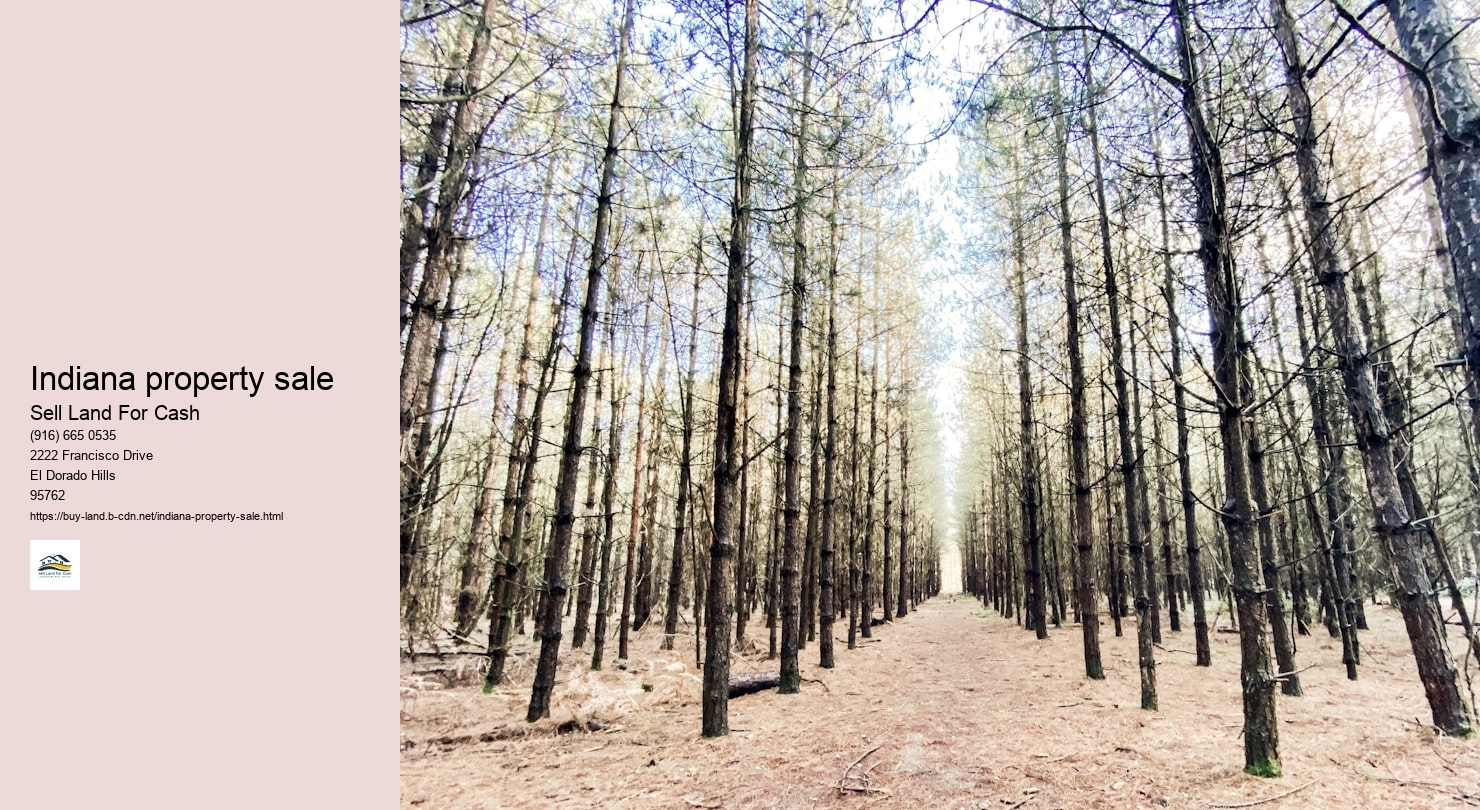

When selling Indiana land for cash, there are several legal considerations that need to be taken into account to ensure a smooth and successful transaction.
Title Search and Clear Title It is crucial to conduct a thorough title search on the property to verify ownership and ensure that there are no liens or encumbrances that could affect the sale. A clear title is essential for a buyer to obtain financing and for the transfer of ownership to be legally valid.
Disclosure Requirements Indiana law requires sellers to disclose certain information about the property, such as any known defects or environmental hazards. Failure to disclose this information can lead to legal consequences, including potential lawsuits from buyers. It is important to fully comply with all disclosure requirements to protect yourself as a seller.
Purchase Agreement A purchase agreement is a legally binding contract that outlines the terms and conditions of the sale, including the purchase price, closing date, and any contingencies. It is advisable to have an experienced real estate attorney review the purchase agreement before signing to ensure that your rights are protected.
Closing Process The closing process involves transferring ownership of the property from the seller to the buyer. This typically includes signing legal documents, paying closing costs, and recording the deed with the county clerk's office. It is important to follow all legal procedures during closing to avoid any delays or complications in finalizing the sale.
Tax Considerations Selling land for cash may have tax implications, such as capital gains taxes or property transfer taxes. It is recommended to consult with a tax professional or accountant before selling your Indiana land for cash to understand your tax obligations and potential deductions.
Legal Assistance Navigating the legal aspects of selling Indiana land for cash can be complex, so it is advisable to seek guidance from a qualified real estate attorney who specializes in land transactions. An attorney can help you understand your rights and obligations as a seller and ensure that all legal requirements are met throughout the sales process.
When you need to sell your Indiana land quickly for cash, there are several strategies you can employ to make the process smoother and more efficient.
First, it is important to assess the market value of your land accurately. This will help you set a realistic selling price that will attract potential buyers. Consider hiring a professional appraiser or real estate agent to assist you in determining the fair market value of your property.
Next, consider marketing your land effectively to reach a wider audience of potential buyers. Utilize online listing platforms, social media channels, and local newspapers to advertise your land for sale. Highlight any unique features or amenities that make your property stand out from others on the market.
Additionally, be prepared to negotiate with potential buyers to close the deal quickly. Consider being flexible with the terms of the sale, such as offering seller financing or accepting a lower offer if it means a faster closing process. Be open to compromises that will help expedite the sale of your Indiana land for cash.
Finally, consider working with a real estate investor or cash buyer who specializes in purchasing land quickly for cash. These professionals can often provide a fast and hassle-free transaction without the need for extensive negotiations or paperwork. By exploring all available options and being proactive in your approach, you can successfully sell your Indiana land quickly for cash.
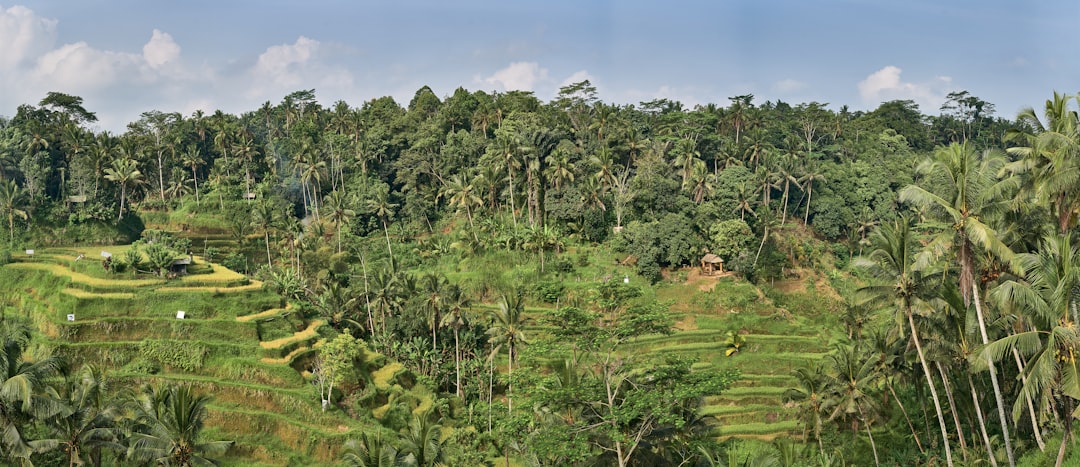
Selling Indiana land for cash can be a rewarding endeavor if approached with strategic planning and informed decision-making.. The process requires understanding the unique aspects of land sales, leveraging market conditions, and utilizing effective marketing techniques to attract potential buyers.
Posted by on 2024-09-30

Selling land for cash in Indiana involves a series of practical and legal steps that require careful consideration and planning.. Whether you are looking to liquidate an inherited property quickly or are simply eager to move on from a piece of land, understanding the process can help ensure a smooth transaction.
Posted by on 2024-09-30
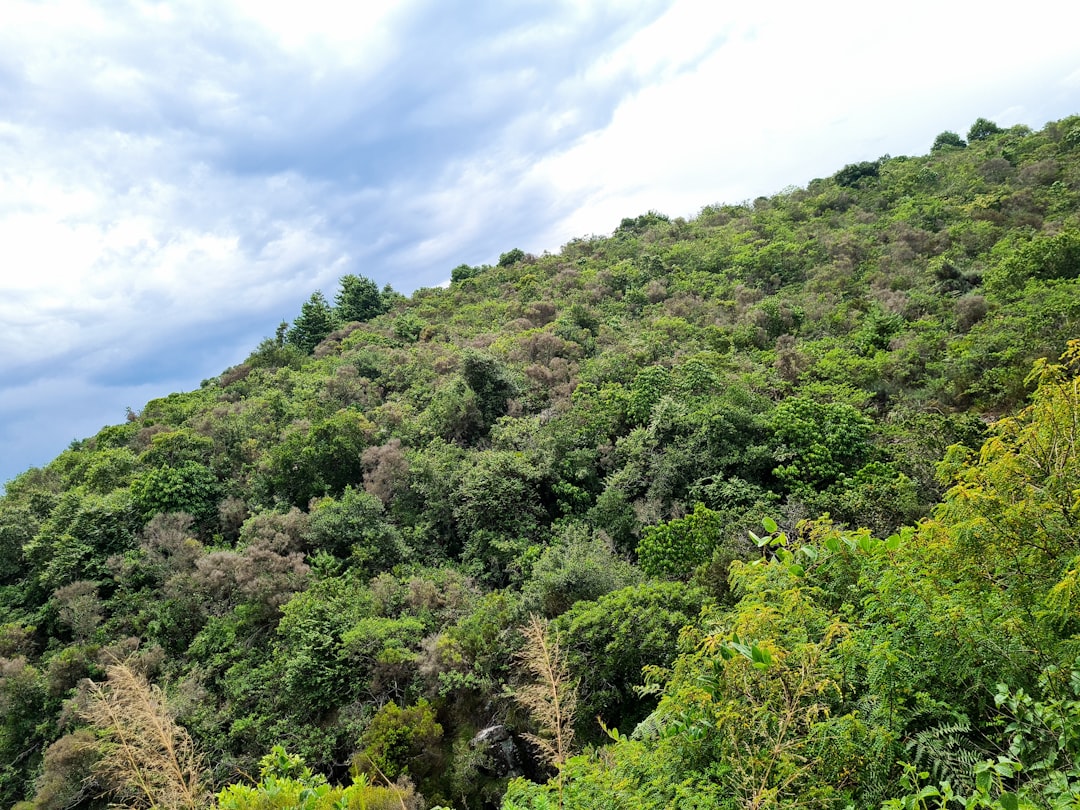
Selling land in Indiana for quick cash can be a straightforward process if approached methodically.. Whether you inherited a plot, no longer have use for it, or simply need liquidity, understanding the steps involved in a swift sale is crucial.
Posted by on 2024-09-30
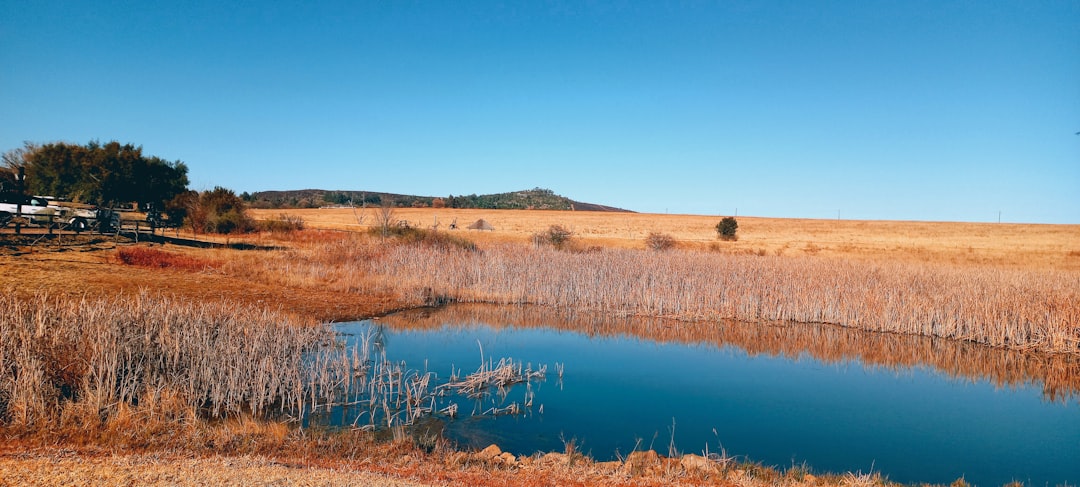
Selling land you own in Indiana for cash can be a strategic financial move, offering a range of benefits that appeal to both the discerning investor and the average landowner.. Whether you're looking to liquidate an asset for immediate needs or planning long-term financial goals, selling your Indiana land for cash can provide substantial advantages.
Posted by on 2024-09-30
When it comes to selling your Indiana property, you want to make sure you get top dollar for it. By following these tips, you can maximize the value of your land and attract buyers willing to pay a premium price.
Highlight the Location: Consider highlighting the location of your property in Indiana. Whether it's close to major cities, near popular attractions, or boasts stunning natural landscapes, emphasizing the location can increase its value in buyers' eyes.
Showcase Potential Uses: Potential buyers are often looking for land that can serve various purposes. Showcase the potential uses of your property such as residential development, farming opportunities, or commercial ventures. Highlighting versatility can attract a wider range of interested parties.
Invest in Professional Photography: High-quality photographs can make a significant difference in attracting buyers and commanding a higher price for your Indiana property. Consider hiring a professional photographer to capture the best features of your land and make it stand out online.
Improve Curb Appeal: Just like with houses, curb appeal matters when selling land. Make sure your Indiana property looks well-maintained and presentable from the roadside. Simple improvements like landscaping, clearing debris, or adding signage can enhance its overall appearance.
Provide Detailed Information: When listing your property for sale, provide detailed information about its features, boundaries, zoning regulations, and any potential restrictions. Clear and accurate information can help build trust with potential buyers and justify a higher asking price.

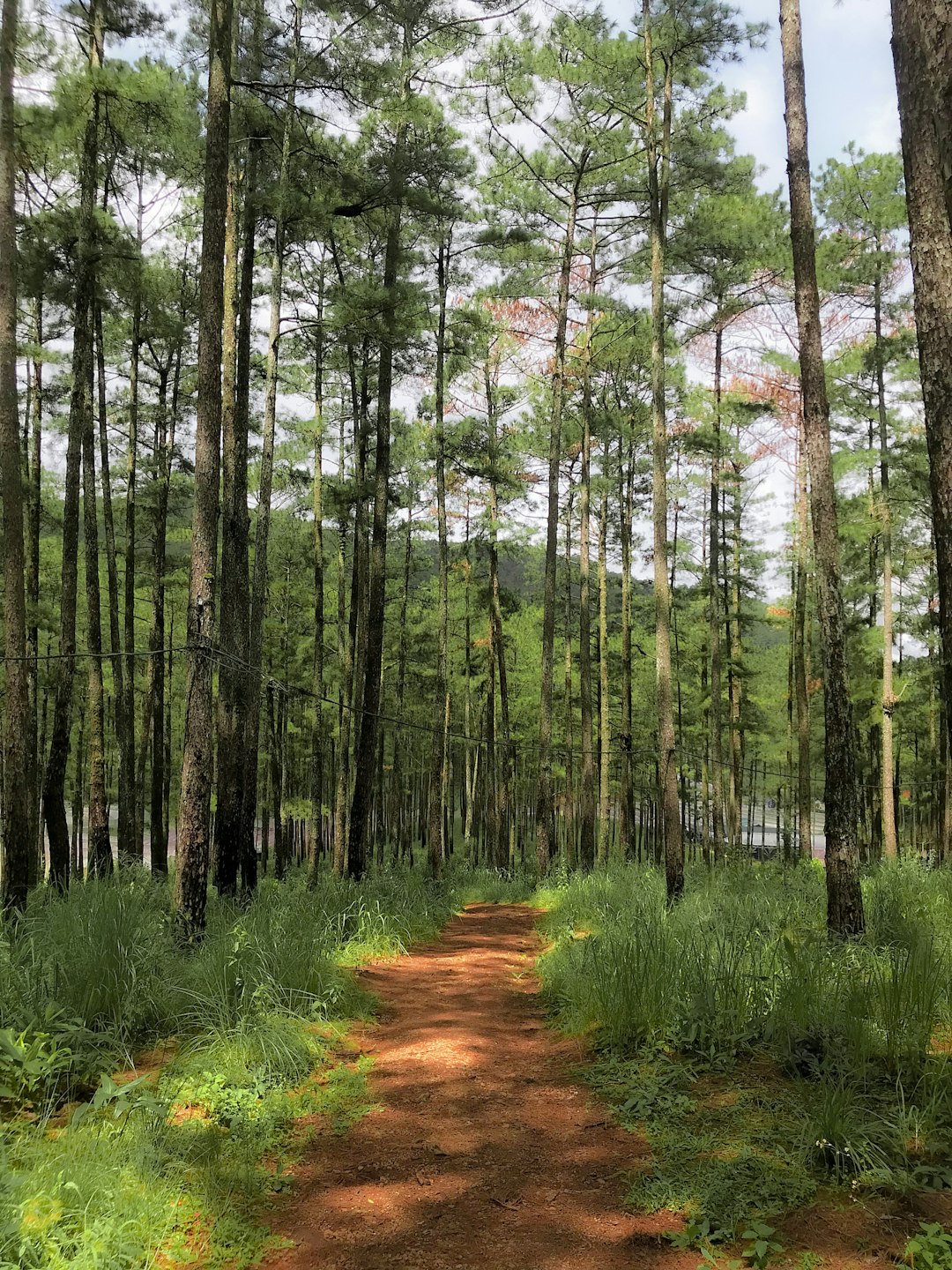
When it comes to selling your Indiana land for cash, finding the best buyers is crucial. Here are some tips to help you connect with the right individuals or companies who are interested in purchasing your property.
Research Local Real Estate Investors: Look for local real estate investors who specialize in buying land in Indiana. These investors have knowledge of the local market and may be willing to offer a fair price for your property. You can find these investors by attending real estate networking events, searching online directories, or asking for recommendations from local real estate agents.
Utilize Online Platforms: Take advantage of online platforms such as social media, real estate websites, and classified ads to reach a wider audience. Create listings that highlight the key features of your land and include high-quality photos to attract potential buyers. Be sure to respond promptly to inquiries and provide detailed information about the property.
Partner with a Real Estate Agent: Consider working with a real estate agent who has experience selling land in Indiana. An agent can help you market your property effectively, negotiate with buyers on your behalf, and handle all the paperwork involved in the sale. Choose an agent who is familiar with the local market and has a proven track record of successful land sales.
Network with Land Developers: Connect with land developers who are looking for opportunities to build residential or commercial properties in Indiana. Attend industry events, join professional organizations, or reach out directly to developers in your area. By building relationships with developers, you may be able to secure a lucrative deal for your land.
Advertise at Local Events: Promote your land for sale at local events such as farmers' markets, community fairs, or trade shows. Set up a booth with flyers, brochures, and other marketing materials that showcase the benefits of buying your property. Engage with attendees and answer any questions they may have about the land.
When it comes to selling your Indiana land quickly, there are several key strategies you can use to market your property effectively. By following these tips, you can attract potential buyers and close the sale in a timely manner.
Highlight the Unique Features of Your Land One of the first steps in marketing your Indiana land is to highlight its unique features. Whether it's a beautiful view, proximity to amenities, or potential for development, make sure to showcase what sets your land apart from others on the market. Use high-quality photos and detailed descriptions to paint a clear picture for potential buyers.
Utilize Online Listings and Social Media In today's digital age, online listings and social media platforms are powerful tools for reaching a wide audience of potential buyers. Make sure to list your Indiana land on popular real estate websites and use social media channels like Facebook and Instagram to promote your property. Engage with followers and respond promptly to inquiries to generate interest.
Partner with a Real Estate Agent Working with a local real estate agent who specializes in land sales can help you reach qualified buyers quickly. An experienced agent will have knowledge of the local market and access to a network of interested clients. They can also handle negotiations and paperwork on your behalf, streamlining the selling process.
Consider Hosting an Open House or Virtual Tour Hosting an open house or virtual tour of your Indiana land can attract serious buyers who want to see the property in person. Make sure the land is well-maintained and easily accessible for visitors. If hosting an in-person event isn't feasible, consider creating a virtual tour using video or 3D technology to give potential buyers a comprehensive view of the property.
Price Your Land Competitively Finally, pricing your Indiana land competitively is crucial for attracting interested buyers quickly. Research similar properties in the area and consult with a real estate agent to determine a fair market value for your land. Setting the right price from the start can help generate more interest and lead to a faster sale.
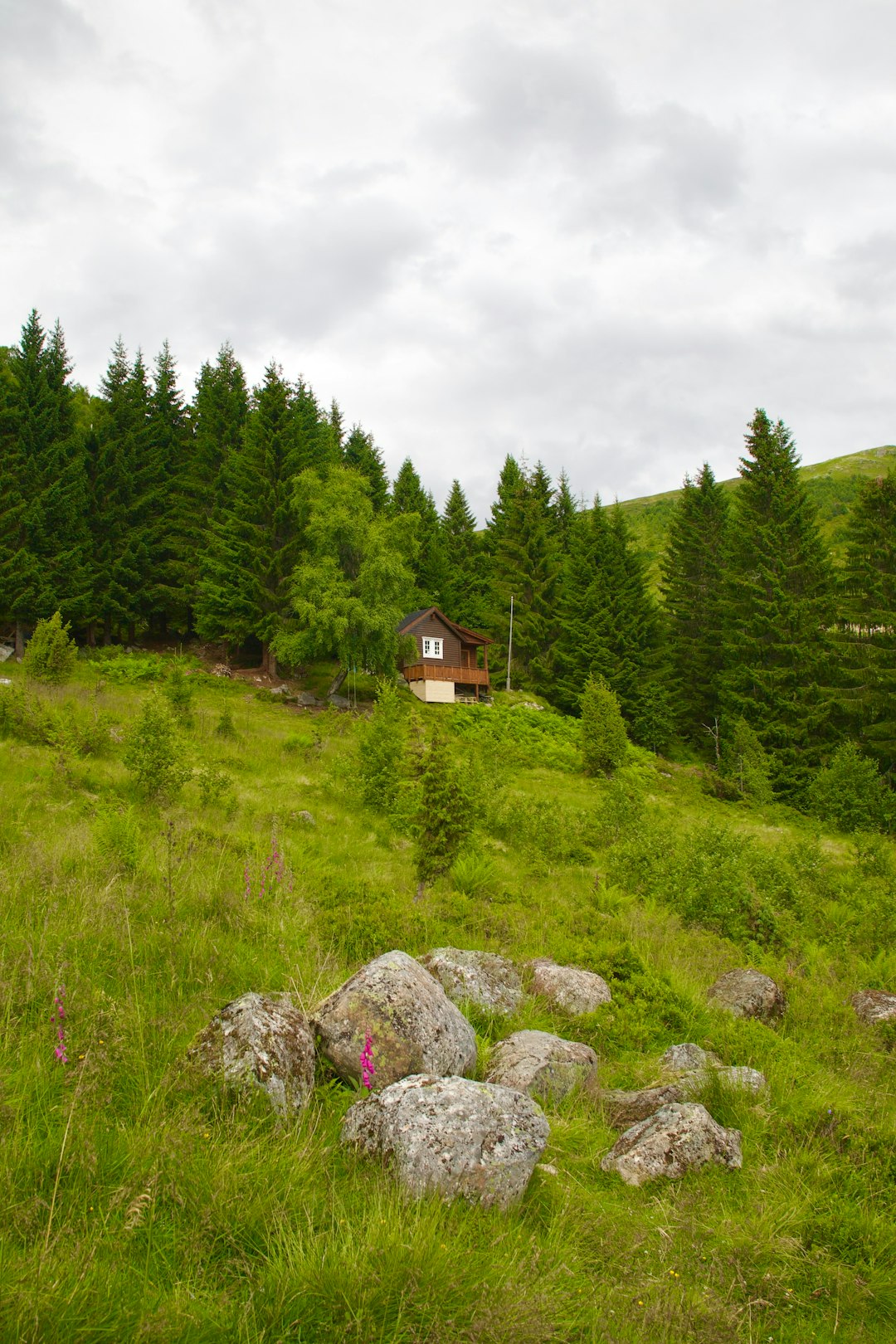
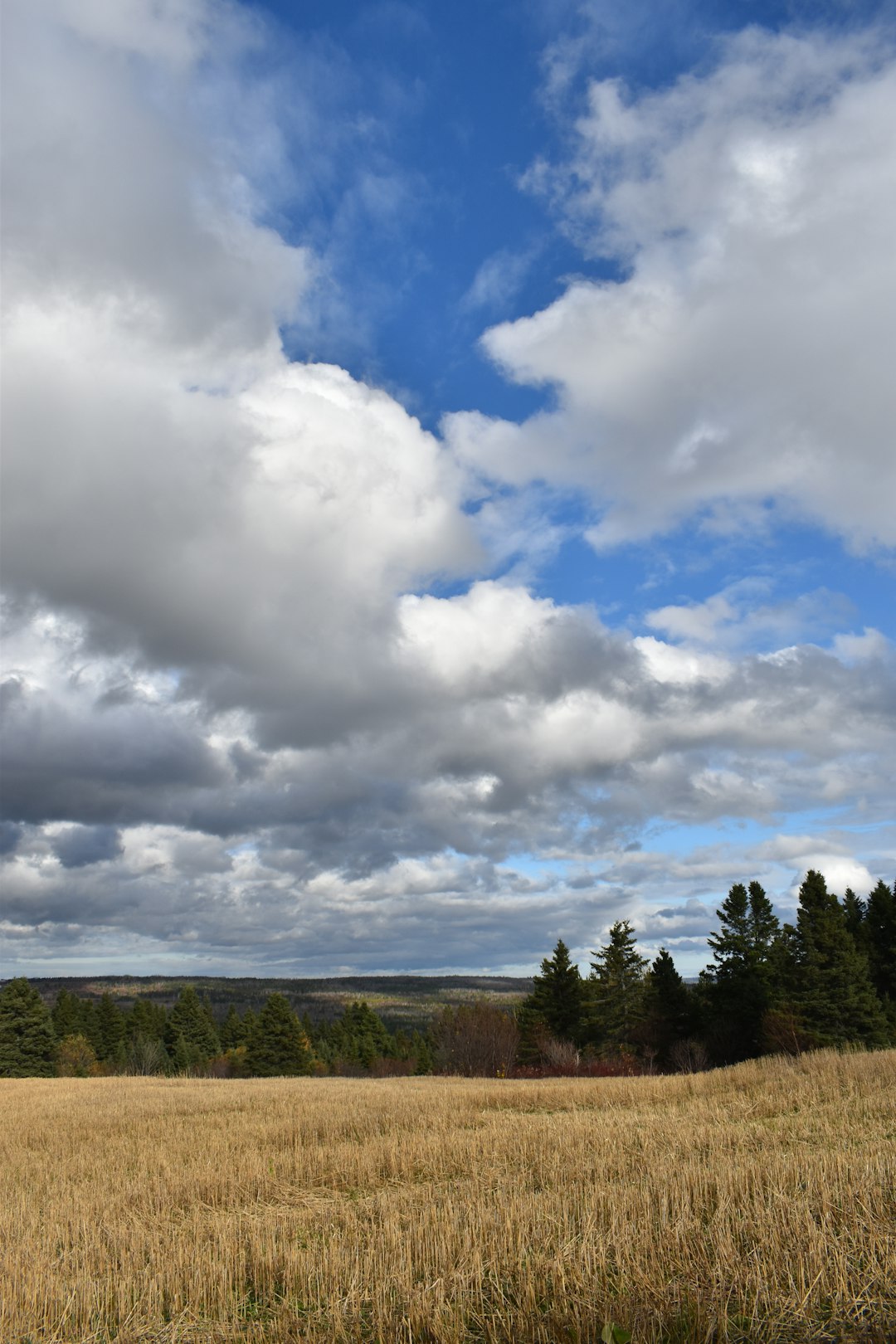
When selling your Indiana property, negotiating the best price is crucial to ensure you get the most value for your land. Here are some tips to help you negotiate the best price for your Indiana property.
Understand the Market Trends Before entering into negotiations, it is essential to understand the current market trends in Indiana. Research recent sales of similar properties in your area to get an idea of what prices are being achieved. Knowing the market will give you leverage during negotiations and help you set a realistic asking price.
Highlight the Unique Features When negotiating with potential buyers, make sure to highlight the unique features of your Indiana property. Whether it's a beautiful view, proximity to amenities, or potential for development, showcasing these aspects can help justify your asking price and make your property stand out from others on the market.
Be Flexible but Firm Negotiations often involve compromise, so be prepared to be flexible during discussions. However, it is also important to remain firm on your bottom line and not settle for less than what you believe your property is worth. Setting clear boundaries will show buyers that you are serious about getting a fair price for your Indiana land.
Consider Hiring a Real Estate Agent If negotiating isn't your strong suit or if you simply want professional guidance throughout the process, consider hiring a real estate agent. An experienced agent can help navigate negotiations, handle paperwork, and ensure that you get the best possible deal for your Indiana property.
Don't Rush Into Decisions Finally, when negotiating the best price for your Indiana property, take your time and don't rush into decisions. Consider all offers carefully, weigh the pros and cons of each proposal, and consult with professionals if needed. Patience and diligence will ultimately lead to a successful negotiation and a favorable outcome for selling your land in Indiana.
When selling Indiana land, it is important to avoid common mistakes that can potentially cost you time and money. By being aware of these pitfalls, you can ensure a smooth and successful transaction.
First and foremost, it is crucial to accurately price your land. Overpricing can deter potential buyers, while underpricing can result in lost profits. Conduct thorough research on comparable properties in the area to determine a fair market value for your land.
Additionally, make sure to properly market your land. Utilize online platforms, social media, signage, and real estate agents to reach a wide pool of potential buyers. Highlight the unique features of your land and its desirable qualities to attract interested parties.
When negotiating with buyers, be open to offers and willing to compromise. Avoid being too rigid in your terms and conditions, as this can drive away serious buyers. Be prepared to negotiate on price, closing costs, or other aspects of the sale to come to a mutually beneficial agreement.
Before finalizing the sale of your Indiana land, ensure that all legal matters are in order. This includes conducting a title search to verify ownership rights and resolving any outstanding liens or encumbrances on the property. Working with an experienced real estate attorney can help you navigate these complexities.
Lastly, do not overlook the importance of proper documentation. Have all agreements and contracts in writing to protect both parties involved in the transaction. Include details such as purchase price, closing date, contingencies, and any other relevant terms to avoid misunderstandings or disputes down the line.
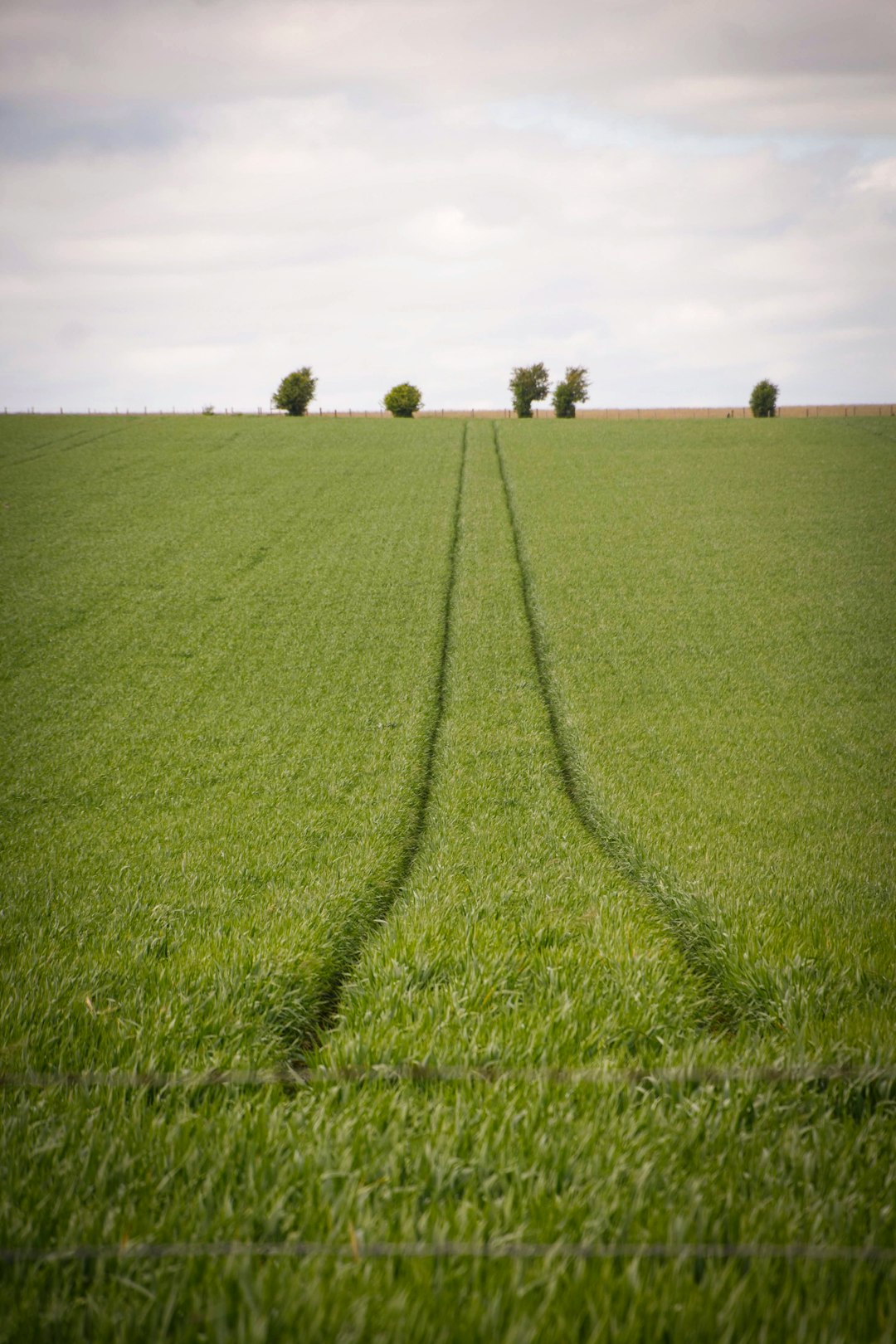
Indiana | |
|---|---|
| State of Indiana | |
| Nickname: "The Hoosier State" | |
| Motto: | |
| Anthem: "On the Banks of the Wabash, Far Away" [1] | |
 Map of the United States with Indiana highlighted | |
| Country | United States |
| Before statehood | Indiana Territory |
| Admitted to the Union | December 11, 1816 (19th) |
| Capital (and largest city) | Indianapolis |
| Largest county or equivalent | Marion |
| Largest metro and urban areas | Indianapolis |
| Government | |
| • Governor | Eric Holcomb (R) |
| • Lieutenant governor | Suzanne Crouch (R) |
| Legislature | General Assembly |
| • Upper house | Indiana Senate |
| • Lower house | Indiana House of Representatives |
| Judiciary | Indiana Supreme Court |
| U.S. senators |
|
| U.S. House delegation |
|
| Area | |
• Total | 36,418 sq mi (94,321 km2) |
| • Land | 35,868 sq mi (92,897 km2) |
| • Water | 550 sq mi (1,424 km2) 1.5% |
| • Rank | 38th |
| Dimensions | |
| • Length | 270 mi (435 km) |
| • Width | 140 mi (225 km) |
| Elevation | 700 ft (210 m) |
| Highest elevation | 1,257 ft (383 m) |
| Lowest elevation | 320 ft (97 m) |
| Population (2020) | |
• Total | 6,785,528[3] |
| • Rank | 17th |
| • Density | 189/sq mi (73.1/km2) |
| • Rank | 16th |
| • Median household income | $62,743 (2,021)[4] |
| • Income rank | 37th |
| Demonym | Hoosier |
| Language | |
| • Official language | English |
| Time zones | |
| 80 counties | UTC−05:00 (Eastern) |
| • Summer (DST) | UTC−04:00 (EDT) |
| 12 counties | UTC−06:00 (Central) |
| • Summer (DST) | UTC−05:00 (CDT) |
| USPS abbreviation | IN |
| ISO 3166 code | US-IN |
| Traditional abbreviation | Ind. |
| Latitude | 37° 46′ N to 41° 46′ N |
| Longitude | 84° 47′ W to 88° 6′ W |
| Website | in |
| List of state symbols | |
|---|---|
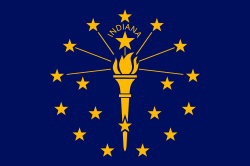 | |
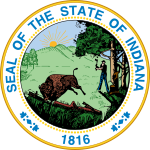 | |
| Poem | "Indiana"[5] |
| Slogan | "IN Indiana"[6] |
| Living insignia | |
| Bird | Northern cardinal[7] (Cardinalis cardinalis) |
| Flower | Peony[8] (Paeonia) |
| Insect | Say's firefly[9] (Pyractomena angulata) |
| Tree | Tulip tree[8] (Liriodendron tulipifera) |
| Inanimate insignia | |
| Color(s) | Blue and gold |
| Firearm | Grouseland Rifle[10] |
| Food | Popcorn (state snack)[11] |
| Fossil | Mastodon[12] (Mammut americanum) |
| Rock | Indiana limestone[13] |
| Other | Wabash River (state river)[13] Republic P-47 Thunderbolt Hoosier Spirit II (state aircraft)[14] |
| State route marker | |
 | |
| State quarter | |
 Released in 2002 | |
| Lists of United States state symbols | |
Indiana (/ˌɪndiˈænə/ IN-dee-AN-ə)[15] is a state in the Midwestern region of the United States. It borders Lake Michigan to the northwest, Michigan to the north and northeast, Ohio to the east, the Ohio River and Kentucky to the south and southeast, and the Wabash River and Illinois to the west. Nicknamed "the Hoosier State",[16] Indiana is the 38th-largest by area and the 17th-most populous of the 50 states. Its capital and largest city is Indianapolis. Indiana was admitted to the Union as the 19th state on December 11, 1816.
Various indigenous peoples inhabited what would become Indiana for thousands of years, some of whom the U.S. government expelled between 1800 and 1836. Indiana received its name because the state was largely possessed by native tribes even after it was granted statehood. Since then, settlement patterns in Indiana have reflected regional cultural segmentation present in the Eastern United States; the state's northernmost tier was settled primarily by people from New England and New York, Central Indiana by migrants from the Mid-Atlantic states and adjacent Ohio, and Southern Indiana by settlers from the Upland South, particularly Kentucky and Tennessee.[17]
Indiana has a diverse economy with a gross state product of $352.62 billion in 2021.[18] It has several metropolitan areas with populations greater than 100,000 and a number of smaller cities and towns. Indiana is home to professional sports teams, including the NFL's Indianapolis Colts and the NBA's Indiana Pacers. The state also hosts several notable competitive events, such as the Indianapolis 500, held at Indianapolis Motor Speedway.
Indiana's name means "Land of the Indians", or simply "Indian Land".[b] It also stems from Indiana's territorial history. On May 7, 1800, the United States Congress passed legislation to divide the Northwest Territory into two areas and named the western section the Indiana Territory. In 1816, when Congress passed an Enabling Act to begin the process of establishing statehood for Indiana, a part of this territorial land became the geographic area for the new state.[c][19][20]
Formal use of the word Indiana dates from 1768, when a Philadelphia-based trading company gave its land claim in present-day West Virginia the name "Indiana" in honor of its previous owners, the Iroquois. Later, ownership of the claim was transferred to the Indiana Land Company, the first recorded use of the word Indiana. But the Virginia colony argued that it was the rightful owner of the land because it fell within its geographic boundaries. The U.S. Supreme Court denied the land company's right to the claim in 1798.[21]
A native or resident of Indiana is known as a Hoosier.[22] The etymology of this word is disputed, but the leading theory, advanced by the Indiana Historical Bureau and the Indiana Historical Society, has its origin in Virginia, Kentucky, the Carolinas, and Tennessee (the Upland South) as a term for a backwoodsman, a rough countryman, or a country bumpkin.[23][24]

The first inhabitants in what is now Indiana were the Paleo-Indians, who arrived about 8000 BC after the melting of the glaciers at the end of the Ice Age. Divided into small groups, the Paleo-Indians were nomads who hunted large game such as mastodons. They created stone tools made out of chert by chipping, knapping and flaking.[25]
The Archaic period, which began between 5000 and 4000 BC, covered the next phase of indigenous culture. The people developed new tools as well as techniques to cook food, an important step in civilization. These new tools included different types of spear points and knives, with various forms of notches. They made ground-stone tools such as stone axes, woodworking tools and grinding stones. During the latter part of the period, they built earthwork mounds and middens, which showed settlements were becoming more permanent. The Archaic period ended at about 1500 BC, although some Archaic people lived until 700 BC.[25]
The Woodland period began around 1500 BC when new cultural attributes appeared. The people created ceramics and pottery and extended their cultivation of plants. An early Woodland period group named the Adena people had elegant burial rituals, featuring log tombs beneath earth mounds. In the middle of the Woodland period, the Hopewell people began to develop long-range trade of goods. Nearing the end of the stage, the people developed highly productive cultivation and adaptation of agriculture, growing such crops as corn and squash. The Woodland period ended around 1000 AD.[25]
The Mississippian culture emerged, lasting from 1000 AD until the 15th century, shortly before the arrival of Europeans. During this stage, the people created large urban settlements designed according to their cosmology, with large mounds and plazas defining ceremonial and public spaces. The concentrated settlements depended on the agricultural surpluses. One such complex was the Angel Mounds. They had large public areas such as plazas and platform mounds, where leaders lived or conducted rituals. Mississippian civilization collapsed in Indiana during the mid-15th century for reasons that remain unclear.[25]
The historic Native American tribes in the area at the time of European encounter spoke different languages of the Algonquian family. They included the Shawnee, Miami, and Illini. Refugee tribes from eastern regions, including the Delaware who settled in the White and Whitewater River Valleys, later joined them.

In 1679, French explorer René-Robert Cavelier, Sieur de La Salle was the first European to cross into Indiana after reaching present-day South Bend at the St. Joseph River.[26] He returned the following year to learn about the region. French-Canadian fur traders soon arrived, bringing blankets, jewelry, tools, whiskey and weapons to trade for skins with the Native Americans.
By 1702, Sieur Juchereau established the first trading post near Vincennes. In 1715, Sieur de Vincennes built Fort Miami at Kekionga, now Fort Wayne. In 1717, another Canadian, Picote de Beletre, built Fort Ouiatenon on the Wabash River, to try to control Native American trade routes from Lake Erie to the Mississippi River.
In 1732, Sieur de Vincennes built a second fur trading post at Vincennes. French Canadian settlers, who had left the earlier post because of hostilities, returned in larger numbers. In a period of a few years, British colonists arrived from the East and contended against the Canadians for control of the lucrative fur trade. Fighting between the French and British colonists occurred throughout the 1750s as a result.
The Native American tribes of Indiana sided with the French Canadians during the French and Indian War (also known as the Seven Years' War). With British victory in 1763, the French were forced to cede to the British crown all their lands in North America east of the Mississippi River and north and west of the colonies.
The tribes in Indiana did not give up: they captured Fort Ouiatenon and Fort Miami during Pontiac's Rebellion. The British royal proclamation of 1763 designated the land west of the Appalachians for Native American use, and excluded British colonists from the area, which the Crown called "Indian Territory".
In 1775, the American Revolutionary War began as the colonists sought self-government and independence from the British. The majority of the fighting took place near the East Coast, but the Patriot military officer George Rogers Clark called for an army to help fight the British in the west.[27] Clark's army won significant battles and took over Vincennes and Fort Sackville on February 25, 1779.[28]
During the war, Clark managed to cut off British troops, who were attacking the eastern colonists from the west. His success is often credited for changing the course of the American Revolutionary War.[29] At the end of the war, through the Treaty of Paris, the British crown ceded their claims to the land south of the Great Lakes to the newly formed United States, including Native American lands.
In 1787, the U.S. defined the Northwest Territory which included the area of present-day Indiana. In 1800, Congress separated Ohio from the Northwest Territory, designating the rest of the land as the Indiana Territory.[30] President Thomas Jefferson chose William Henry Harrison as the governor of the territory, and Vincennes was established as the capital.[31] After the Michigan Territory was separated and the Illinois Territory was formed, Indiana was reduced to its current size and geography.[30]
Starting with the Battle of Fallen Timbers in 1794 and the Treaty of Greenville in 1795, Native American titles to Indiana lands were extinguished by usurpation, purchase, or war and treaty. About half the state was acquired in the Treaty of St. Mary's from the Miami in 1818. Purchases were not complete until the Treaty of Mississinewas in 1826 acquired the last of the reserved Native American lands in the northeast.
A portrait of the Indiana frontier about 1810: The frontier was defined by the Treaty of Fort Wayne in 1809, adding much of the southwestern lands around Vincennes and southeastern lands adjacent to Cincinnati, to areas along the Ohio River as part of U.S. territory. Settlements were military outposts such as Fort Ouiatenon in the northwest and Fort Miami (later Fort Wayne) in the northeast, Fort Knox and Vincennes settlement on the lower Wabash. Other settlements included Clarksville (across from Louisville), Vevay, and Corydon along the Ohio River, the Quaker Colony in Richmond on the eastern border, and Conner's Post (later Connersville) on the east central frontier. Indianapolis would not be populated for 15 more years, and central and northern Indiana Territory remained wilderness populated primarily by Indigenous communities. Only two counties in the extreme southeast, Clark and Dearborn, had been organized by European settlers. Land titles issued out of Cincinnati were sparse. Settler migration was chiefly via flatboat on the Ohio River westerly, and by wagon trails up the Wabash/White River Valleys (west) and Whitewater River Valleys (east).
In 1810, the Shawnee tribal chief Tecumseh and his brother Tenskwatawa encouraged other indigenous tribes in the territory to resist European settlement. Tensions rose and the U.S. authorized Harrison to launch a preemptive expedition against Tecumseh's Confederacy; the U.S. gained victory at the Battle of Tippecanoe on November 7, 1811. Tecumseh was killed in 1813 during the Battle of Thames. After his death, armed resistance to United States control ended in the region. Most Native American tribes in the state were later removed to west of the Mississippi River in the 1820s and 1830s after U.S. negotiations and the purchase of their lands.[32]
Corydon, a town in the far southern part of Indiana, was named the second capital of the Indiana Territory in May 1813 in order to decrease the threat of Native American raids following the Battle of Tippecanoe.[30] Two years later, a petition for statehood was approved by the territorial general assembly and sent to Congress. An Enabling Act was passed to provide an election of delegates to write a constitution for Indiana. On June 10, 1816, delegates assembled at Corydon to write the constitution, which was completed in 19 days. Jonathan Jennings was elected the fledgling state's first governor in August 1816. President James Madison approved Indiana's admission into the union as the nineteenth state on December 11, 1816.[28] In 1825, the state capital was moved from Corydon to Indianapolis.[30]
 |
 |
Many European immigrants went west to settle in Indiana in the early 19th century. The largest immigrant group to settle in Indiana were Germans, as well as many immigrants from Ireland and England. Americans who were primarily ethnically English migrated from the Northern Tier of New York and New England, as well as from the mid-Atlantic state of Pennsylvania.[34][35] The arrival of steamboats on the Ohio River in 1811, and the National Road at Richmond in 1829, greatly facilitated settlement of northern and western Indiana.
Following statehood, the new government worked to transform Indiana from a frontier into a developed, well-populated, and thriving state, beginning significant demographic and economic changes. In 1836, the state's founders initiated a program, the Indiana Mammoth Internal Improvement Act, that led to the construction of roads, canals, railroads and state-funded public schools. The plans bankrupted the state and were a financial disaster, but increased land and produce value more than fourfold.[36] In response to the crisis and in order to avert another, in 1851, a second constitution was adopted. Among its provisions were a prohibition on public debt, as well as the extension of suffrage to African-Americans.
During the American Civil War, Indiana became politically influential and played an important role in the affairs of the nation. Indiana was the first western state to mobilize for the United States in the war, and soldiers from Indiana participated in all the war's major engagements. The state provided 126 infantry regiments, 26 batteries of artillery and 13 regiments of cavalry to the Union.[37]
In 1861, Indiana was assigned a quota of 7,500 soldiers to join the Union Army.[38] So many volunteered in the first call that thousands had to be turned away. Before the war ended, Indiana had contributed 208,367 men. Casualties were over 35% among these men: 24,416 lost their lives and over 50,000 more were wounded.[39] The only Civil War conflicts fought in Indiana were the Newburgh Raid, a bloodless capture of the city; and the Battle of Corydon, which occurred during Morgan's Raid leaving 15 dead, 40 wounded, and 355 captured.[40]
After the war, Indiana remained a largely agricultural state. Post-war industries included mining, including limestone extraction; meatpacking; food processing, such as milling grain, distilling it into alcohol; and the building of wagons, buggies, farm machinery, and hardware.[41] However, the discovery of natural gas in the 1880s in northern Indiana led to an economic boom: the abundant and cheap fuel attracted heavy industry; the availability of jobs, in turn, attracted new settlers from other parts of the country as well as from Europe.[42] This led to the rapid expansion of cities such as South Bend, Indianapolis, and Fort Wayne.[41]
The early decades of the 20th century saw Indiana develop into a leading manufacturing state with heavy industry concentrating in the north.[34] In 1906 the United States Steel Corporation created a new industrial city on Lake Michigan, Gary, named after Elbert Henry Gary, its founding chairman. With industrialization, workers developed labor unions (their strike activities induced governor James P. Goodrich to declare martial law in Gary in 1919)[43] and a socialist party.[44] Railroader Eugene Debs of Terre Haute, the Socialist candidate received 901,551 votes (6.0% of the national vote) in the 1912 presidential election.[45] Suffrage movements also arose to enfranchise women.[42]
In its earlier years, Indiana was a leader in the automobile boom. Beginning its production in Kokomo in 1896, Haynes-Apperson was the nation's first commercially successful auto company.[46] The importance of vehicle and parts manufacture to the state was symbolized by the construction in 1909 of the Indianapolis Motor Speedway.[47]
In the 1920s, state politics was heavily influenced by the rise of the Indiana Klan. First organized in 1915 as a branch of the Ku Klux Klan, it appealed to white Protestants alarmed by social and economic trends, including changes induced by immigration from southern and central Europe.[48] In the name of defending "hundred-per-cent Americanism", the Klan sought exclude from public life "Bolsheviks, Catholics, Jews, Negroes, bootleggers, pacifists, evolutionists, foreigners, and all persons it considered immoral".[49]
By 1925 the Klan had 250,000 members, an estimated 30% of native-born white men.[50][51] By 1925 over half the elected members of the Indiana General Assembly, the governor of Indiana, and many other high-ranking officials in local and state government were members of the Klan. Politicians had also learned they needed Klan endorsement to win office.[52] That year, "Grand Dragon" D.C. Stephenson, who had begun to brag "I am the law in Indiana",[53] was charged and convicted for the rape and murder of Madge Oberholtzer, a young schoolteacher. Denied pardon, in 1927 Stephenson gave the Indianapolis Times lists of people the Klan had paid. Partly as a result of compounded scandal, membership collapsed.[54]
Throughout the 1930s, Democrats were in power and "the Klan was political poison".[55] During those years, Indiana, like the rest of the nation, was affected by the Great Depression. The economic downturn had a wide-ranging negative impact on Indiana, such as the decline of urbanization. The Dust Bowl to the west led many migrants to flee to the more industrialized Midwest. Governor Paul V. McNutt's administration struggled to build a state-funded welfare system to help overwhelmed private charities. During his administration, spending and taxes were both cut drastically in response to the Depression, and the state government was completely reorganized. McNutt ended Prohibition in the state and enacted the state's first income tax. On several occasions, he declared martial law to put an end to worker strikes.[56]
World War II helped lift Indiana's economy, as the war required steel, food and other goods the state produced.[57] Roughly 10% of Indiana's population joined the armed forces, while hundreds of industries earned war production contracts and began making war material.[58] Indiana manufactured 4.5% of total U.S. military armaments during World War II, ranking eighth among the 48 states.[59] The expansion of industry to meet war demands helped end the Great Depression.[57]
With the conclusion of World War II, Indiana rebounded to pre-Depression levels of production. Industry became the primary employer, a trend that continued into the 1960s. Urbanization during the 1950s and 1960s led to substantial growth in the state's cities. The auto, steel and pharmaceutical industries topped Indiana's major businesses. Indiana's population continued to grow after the war, exceeding five million by the 1970 census.[60] In the 1960s the administration of Matthew E. Welsh adopted its first sales tax of 2%.[61] Indiana schools were desegregated in 1949. In 1950, the U.S. Census Bureau reported Indiana's population as 95.5% white and 4.4% black.[62] Governor Welsh also worked with the General Assembly to pass the Indiana Civil Rights Bill, granting equal protection to minorities in seeking employment.[63]
On December 8, 1964, a Convair B-58 carrying nuclear weapons slid off an icy runway on Bunker Hill Air Force Base in Bunker Hill, Indiana and caught fire during a training drill. The five nuclear weapons on board were burned, including one 9-megaton thermonuclear weapon, causing radioactive contamination of the crash area.[64]
Beginning in 1970, a series of amendments to the state constitution were proposed. With adoption, the Indiana Court of Appeals was created and the procedure of appointing justices on the courts was adjusted.[65]
The 1973 oil crisis created a recession that hurt the automotive industry in Indiana. Companies such as Delco Electronics and Delphi began a long series of downsizing that contributed to high unemployment rates in manufacturing in Anderson, Muncie, and Kokomo. The restructuring and deindustrialization trend continued until the 1980s when the national and state economy began to diversify and recover.[66]

With a total area (land and water) of 36,418 square miles (94,320 km2), Indiana ranks as the 38th largest state in size.[67] The state has a maximum dimension north to south of 250 miles (400 km) and a maximum east to west dimension of 145 miles (233 km).[68] The state's geographic center (39° 53.7'N, 86° 16.0W) is in Marion County.[69]
Located in the Midwestern United States, Indiana is one of eight states that make up the Great Lakes Region.[70] Indiana is bordered on the north by Michigan, on the east by Ohio, and on the west by Illinois, partially separated by the Wabash River.[71] Lake Michigan borders Indiana on the northwest and the Ohio River separates Indiana from Kentucky on the south.[69][72]
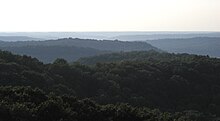
The average altitude of Indiana is about 760 feet (230 m) above sea level.[73] The highest point in the state is Hoosier Hill in Wayne County at 1,257 feet (383 m) above sea level.[67][74] The lowest point at 320 feet (98 m) above sea level is in Posey County, where the Wabash River meets the Ohio River.[67][69] The resulting elevation span, 937 feet (286 m), is the narrowest of any non-coastal U.S. state. Only 2,850 square miles (7,400 km2) have an altitude greater than 1,000 feet (300 m) and this area is enclosed within 14 counties. About 4,700 square miles (12,000 km2) have an elevation of less than 500 feet (150 m), mostly concentrated along the Ohio and lower Wabash Valleys, from Tell City and Terre Haute to Evansville and Mount Vernon.[75]
The state includes two natural regions of the United States: the Central Lowlands and the Interior Low Plateaus.[76] The till plains make up the northern and central regions of Indiana. Much of its appearance is a result of elements left behind by glaciers. Central Indiana is mainly flat with some low rolling hills (except where rivers cut deep valleys through the plain, like at the Wabash River and Sugar Creek) and soil composed of glacial sands, gravel and clay, which results in exceptional farmland.[71] Northern Indiana is similar, except for the presence of higher and hillier terminal moraines and hundreds of kettle lakes. In northwest Indiana there are various sand ridges and dunes, some reaching nearly 200 feet in height; most of them are at Indiana Dunes National Park. These are along the Lake Michigan shoreline and also inland to the Kankakee Outwash Plain.
Southern Indiana is characterized by valleys and rugged, hilly terrain, contrasting with much of the state. Here, bedrock is exposed at the surface. Because of the prevalent Indiana limestone, the area has many caves, caverns, and quarries.

Major river systems in Indiana include the Whitewater, White, Blue, Wabash, St. Joseph, and Maumee rivers.[77] According to the Indiana Department of Natural Resources, as of 2007, there were 65 rivers, streams, and creeks of environmental interest or scenic beauty, which included only a portion of an estimated 24,000 total river miles within the state.[78]
The Wabash River, which is the longest free-flowing river east of the Mississippi River, is the official river of Indiana.[79][80] At 475 miles (764 kilometers) in length, the river bisects the state from northeast to southwest, forming part of the state's border with Illinois, before converging with the Ohio River. The river has been the subject of several songs, such as "On the Banks of the Wabash, Far Away", "Wabash Cannonball", and "Back Home Again in Indiana".[81][82]
There are about 900 lakes listed by the Indiana Department of Natural Resources.[83] To the northwest, Indiana borders Lake Michigan, one of five lakes comprising the Great Lakes, the largest group of freshwater lakes in the world. Tippecanoe Lake, the deepest lake in the state, reaches depths at nearly 120 feet (37 m), while Lake Wawasee is the largest natural lake in Indiana.[84] At 10,750 acres (summer pool level), Monroe Lake is the largest lake in Indiana.[85]

In the past, almost all of Indiana had a humid continental climate (Dfb), with cold winters and hot, wet summers;[86] only the extreme southern portion of the state lay within the humid subtropical climate (Cfa), which receives more precipitation than other parts of Indiana.[71] But as of the 2016 update, about half the state is now classified as humid subtropical. Temperatures generally diverge from the north and south sections of the state. In midwinter, average high/low temperatures range from around 30 °F/15 °F (−1 °C/−10 °C) in the far north to 41 °F/24 °F (5 °C/−4 °C) in the far south.[87]
In midsummer there is generally a little less variation across the state, as average high/low temperatures range from around 84 °F/64 °F (29 °C/18 °C) in the far north to 90 °F/69 °F (32 °C/21 °C) in the far south.[87] Indiana's record high temperature was 116 °F (47 °C) set on July 14, 1936, at Collegeville. The record low was −36 °F (−38 °C) on January 19, 1994 at New Whiteland.[88] The growing season typically spans from 155 days in the north to 185 days in the south.[citation needed]
While droughts occasionally occur in the state, rainfall totals are distributed relatively equally throughout the year. Precipitation totals range from 35 inches (89 cm) near Lake Michigan in northwest Indiana to 45 inches (110 cm) along the Ohio River in the south, while the state's average is 40 inches (100 cm). Annual snowfall in Indiana varies widely across the state, ranging from 80 inches (200 cm) in the northwest along Lake Michigan to 14 inches (36 cm) in the far south. Lake effect snow accounts for roughly half the snowfall in northwest and north central Indiana due to the effects of the moisture and relative warmth of Lake Michigan upwind. The mean wind speed is 8 miles per hour (13 km/h).[89]
In a 2012 report, Indiana was ranked eighth in a list of the top 20 tornado-prone states based on National Weather Service data from 1950 through 2011.[90] A 2011 report ranked South Bend 15th among the top 20 tornado-prone U.S. cities,[91] while another report from 2011 ranked Indianapolis eighth.[92][d][e]Despite its vulnerability, Indiana is not part of Tornado Alley.[93]
| Average precipitation in Indiana[94] | ||||||||||||
| Jan | Feb | Mar | Apr | May | Jun | Jul | Aug | Sep | Oct | Nov | Dec | Annum |
|---|---|---|---|---|---|---|---|---|---|---|---|---|
| 2.48 | 2.27 | 3.36 | 3.89 | 4.46 | 4.19 | 4.22 | 3.91 | 3.12 | 3.02 | 3.44 | 3.13 | 41.49 |
| Location | July (°F) | July (°C) | January (°F) | January (°C) |
|---|---|---|---|---|
| Indianapolis | 85/66 | 29/19 | 35/20 | 2/−6 |
| Fort Wayne | 84/62 | 29/17 | 32/17 | 0/−8 |
| Evansville | 88/67 | 31/19 | 41/24 | 5/−4 |
| South Bend | 83/63 | 28/17 | 32/18 | 0/−8 |
| Bloomington | 87/65 | 30/18 | 39/21 | 4/−6 |
| Lafayette | 84/62 | 29/17 | 31/14 | 0/−10 |
| Muncie | 85/64 | 29/18 | 34/19 | 1/−7 |
Indiana is one of 13 U.S. states that are divided into more than one time zone. Indiana's time zones have fluctuated over the past century. At present most of the state observes Eastern Time; six counties near Chicago and six near Evansville observe Central Time.[96] Debate continues on the matter.[97]
Before 2006, most of Indiana did not observe daylight saving time (DST). Some counties within this area, particularly Floyd, Clark, and Harrison counties near Louisville, Kentucky, and Ohio and Dearborn counties near Cincinnati, Ohio, unofficially observed DST by local custom. Since April 2006 the entire state observes DST.[98]
Indiana is divided into 92 counties. As of 2010[update], the state includes 16 metropolitan and 25 micropolitan statistical areas, 117 incorporated cities, 450 towns, and several other smaller divisions and statistical areas.[99][f] Marion County and Indianapolis have a consolidated city-county government.[99]
Indianapolis is the capital of Indiana and its largest city.[99][g] Indiana's four largest metropolitan areas are Indianapolis, Fort Wayne, Evansville, and South Bend.[100] The table below lists the state's twenty largest municipalities based on the 2020 United States census.[101]
| Rank | Name | County | Pop. | Rank | Name | County | Pop. | ||
|---|---|---|---|---|---|---|---|---|---|
 Indianapolis  Fort Wayne |
1 | Indianapolis | Marion | 887,642 | 11 | Gary | Lake | 69,093 |  Evansville  South Bend |
| 2 | Fort Wayne | Allen | 263,886 | 12 | Muncie | Delaware | 65,194 | ||
| 3 | Evansville | Vanderburgh | 117,298 | 13 | Greenwood | Johnson | 63,830 | ||
| 4 | South Bend | St. Joseph | 103,453 | 14 | Kokomo | Howard | 59,604 | ||
| 5 | Carmel | Hamilton | 99,757 | 15 | Terre Haute | Vigo | 58,389 | ||
| 6 | Fishers | Hamilton | 98,977 | 16 | Anderson | Madison | 54,788 | ||
| 7 | Bloomington | Monroe | 79,168 | 17 | Elkhart | Elkhart | 53,923 | ||
| 8 | Hammond | Lake | 77,879 | 18 | Mishawaka | St. Joseph | 51,063 | ||
| 9 | Lafayette | Tippecanoe | 70,783 | 19 | Columbus | Bartholomew | 50,474 | ||
| 10 | Noblesville | Hamilton | 69,604 | 20 | Jeffersonville | Clark | 49,447 | ||
| Census | Pop. | Note | %± |
|---|---|---|---|
| 1800 | 2,632 | — | |
| 1810 | 24,520 | 831.6% | |
| 1820 | 147,178 | 500.2% | |
| 1830 | 343,031 | 133.1% | |
| 1840 | 685,866 | 99.9% | |
| 1850 | 988,416 | 44.1% | |
| 1860 | 1,350,428 | 36.6% | |
| 1870 | 1,680,637 | 24.5% | |
| 1880 | 1,978,301 | 17.7% | |
| 1890 | 2,192,404 | 10.8% | |
| 1900 | 2,516,462 | 14.8% | |
| 1910 | 2,700,876 | 7.3% | |
| 1920 | 2,930,390 | 8.5% | |
| 1930 | 3,238,503 | 10.5% | |
| 1940 | 3,427,796 | 5.8% | |
| 1950 | 3,934,224 | 14.8% | |
| 1960 | 4,662,498 | 18.5% | |
| 1970 | 5,193,669 | 11.4% | |
| 1980 | 5,490,224 | 5.7% | |
| 1990 | 5,544,159 | 1.0% | |
| 2000 | 6,080,485 | 9.7% | |
| 2010 | 6,483,802 | 6.6% | |
| 2020 | 6,785,528 | 4.7% | |
| 2023 (est.) | 6,862,199 | [102] | 1.1% |
| Source: 1910–2020[103] | |||
Indiana recorded a population of 6,785,528 in the 2020 United States census, a 4.65% increase since the 2010 United States census.[3]
The state's population density was 181.0 persons per square mile, the 16th-highest in the United States.[99] As of the 2010 U.S. census, Indiana's population center is northwest of Sheridan, in Hamilton County (+40.149246, −086.259514).[99][104][h]
In 2005, 77.7% of Indiana residents lived in metropolitan counties, 16.5% lived in micropolitan counties and 5.9% lived in non-core counties.[105]
According to HUD's 2022 Annual Homeless Assessment Report, there were an estimated 5,449 homeless people in Indiana.[106][107]
In 2018, the top countries of origin for Indiana's immigrants were Mexico, India, China, Myanmar, and the Philippines.[108]

| Race and ethnicity[109] | Alone | Total | ||
|---|---|---|---|---|
| White (non-Hispanic) | 75.5% | 79.1% | ||
| African American (non-Hispanic) | 9.4% | 10.8% | ||
| Hispanic or Latino[i] | — | 8.2% | ||
| Asian | 2.5% | 3.1% | ||
| Native American | 0.2% | 1.6% | ||
| Pacific Islander | 0.04% | 0.2% | ||
| Other | 0.4% | 1.1% | ||
| Racial composition | 1990[110] | 2000[111] | 2010[112] | 2020[113] |
|---|---|---|---|---|
| White | 90.6% | 87.5% | 84.3% | 77.2% |
| Black | 7.8% | 8.4% | 9.1% | 9.6% |
| Asian | 0.7% | 1.0% | 1.6% | 2.5% |
| Native | 0.2% | 0.3% | 0.3% | 0.4% |
| Native Hawaiian and other Pacific Islander |
– | – | – | – |
| Other race | 0.7% | 1.6% | 2.7% | 3.9% |
| Two or more races | – | 1.2% | 2.0% | 6.4% |
German is the largest ancestry reported in Indiana, with 18.8% of the population reporting that ancestry in the census. Persons listing themselves as American (7.2%) and those of English ancestry (11.1%) are also numerous, as are Irish (9.8%) and Polish (2.6%).[114] Most of those citing American ancestry are actually of European descent, including many of English descent, but have family that has been in North America for so long, in many cases since the early colonial era, that they identify simply as American.[115][116][117][118] In the 1980 census 1,776,144 people claimed German ancestry, 1,356,135 claimed English ancestry and 1,017,944 claimed Irish ancestry out of a total population of 4,241,975 making the state 42% German, 32% English and 24% Irish.[119]
The state is home to a growing Hispanic population, making up 7.8% of the total population. The largest Hispanic ancestry in the state is Mexican (5.3%), making up a large majority of the Hispanic population.[120]
The majority (62%) of the state's African American population is concentrated in Marion and Lake counties, in and around the cities of Indianapolis and Gary.[121]
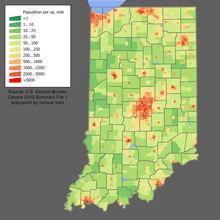

| Non-Hispanic White 50–60% 60–70% 70–80% 80–90% 90%+ |
Population growth since 1990 has been concentrated in the counties surrounding Indianapolis, with four of the five fastest-growing counties in that area: Hamilton, Hendricks, Johnson, and Hancock. The other county is Dearborn County, which is near Cincinnati, Ohio. Hamilton County has also grown faster than any county in the states bordering Indiana (Illinois, Michigan, Ohio and Kentucky), and is the 20th-fastest growing county in the country.[122]
With a population of 829,817, Indianapolis is the largest city in Indiana and the 12th-largest in the United States, according to the 2010 census. Three other cities in Indiana have a population greater than 100,000: Fort Wayne (253,617), Evansville (117,429) and South Bend (101,168).[123] Since 2000, Fishers has seen the largest population rise amongst the state's twenty largest cities with an increase of 100%.[124] Other cities that have seen extensive growth since 2000 are Greenwood (81%), Noblesville (39.4%), Carmel (21.4%), Columbus[125] (12.8%) and Lawrence (9.3%).
Gary and Hammond have had the largest population declines regarding the 20 largest cities since 2000, with a decrease of 21.0% and 6.8% respectively.[124] Evansville (−4.2%), Anderson (−4.0%) and Muncie (−3.9%) have also had declines.[126]
Indianapolis has the largest population of the state's metropolitan areas and the 33rd-largest in the country.[127] The Indianapolis metropolitan area encompasses Marion County and nine surrounding counties in central Indiana.
Note: Births in table don't add up, because Hispanics are counted both by their ethnicity and by their race, giving a higher overall number.
| Race | 2013[128] | 2014[129] | 2015[130] | 2016[131] | 2017[132] | 2018[133] | 2019[134] | 2020[135] | 2021[136] | 2022[137] |
|---|---|---|---|---|---|---|---|---|---|---|
| White: | 70,166 (84.4%) | 70,967 (84.4%) | 70,741 (84.1%) | ... | ... | ... | ... | ... | ... | ... |
| > Non-Hispanic White | 63,820 (76.8%) | 64,076 (76.2%) | 63,472 (75.5%) | 62,039 (74.7%) | 60,515 (73.6%) | 59,520 (72.9%) | 58,211 (72.0%) | 56,290 (71.6%) | 56,839 (71.1%) | 55,178 (69.3%) |
| Black | 10,445 (12.6%) | 10,666 (12.7%) | 10,656 (12.7%) | 9,768 (11.8%) | 9,971 (12.1%) | 10,242 (12.5%) | 10,249 (12.7%) | 9,848 (12.5%) | 9,991 (12.5%) | 10,119 (12.7%) |
| Asian | 2,364 (2.8%) | 2,322 (2.8%) | 2,523 (3.0%) | 2,426 (2.9%) | 2,535 (3.1%) | 2,382 (2.9%) | 2,285 (2.8%) | 2,335 (3.0%) | 2,295 (2.9%) | 2,458 (3.1%) |
| American Indian | 127 (0.1%) | 125 (0.1%) | 120 (0.1%) | 85 (0.1%) | 124 (0.2%) | 132 (0.2%) | 117 (0.1%) | 56 (>0.1%) | 76 (>0.1%) | 126 (0.2%) |
| Hispanic (of any race) | 6,837 (8.2%) | 7,239 (8.6%) | 7,634 (9.1%) | 7,442 (8.9%) | 7,669 (9.3%) | 7,867 (9.6%) | 8,420 (10.4%) | 8,480 (10.8%) | 8,826 (11.0%) | 9,939 (12.5%) |
| Total Indiana | 83,102 (100%) | 84,080 (100%) | 84,040 (100%) | 83,091 (100%) | 82,170 (100%) | 81,646 (100%) | 80,859 (100%) | 78,616 (100%) | 79,946 (100%) | 79,649 (100%) |
Based on population estimates for 2011, 6.6% of the state's population is under the age of five, 24.5% is under the age of 18, and 13.2% is 65 years of age or older.[138] From the 2010 U.S. census demographic data for Indiana, the median age is 37.[139]

As of the 2010 census, Indiana's median household income was $44,616, ranking it 36th among the United States and the District of Columbia.[140] In 2005, the median household income for Indiana residents was $43,993. Nearly 498,700 Indiana households had incomes between $50,000 and $75,000, accounting for 20% of all households.[141]
Hamilton County's median household income is nearly $35,000 higher than the Indiana average. At $78,932, it ranks seventh in the country among counties with fewer than 250,000 people. The next highest median incomes in Indiana are also found in the Indianapolis suburbs; Hendricks County has a median of $57,538, followed by Johnson County at $56,251.[141]

Although the largest single religious denomination in the state is Catholic (747,706 members), most Hoosiers are members of various Protestant denominations. The largest Protestant denomination by number of adherents in 2010 was the United Methodist Church, with 355,043.[143] A study by the Graduate Center at the City University of New York found 20% are Catholic, 14% belong to Baptist churches, 10% are other Christians, 9% are Methodist, and 6% are Lutheran. The study found 16% are affiliated with no religion.[144]
Indiana is home to the Benedictine St. Meinrad Archabbey, one of two Catholic archabbeys in the United States and 11 in the world. The Lutheran Church–Missouri Synod has one of its two seminaries in Fort Wayne. Two evangelical Methodist denominations, the Free Methodist Church and the Wesleyan Church, are headquartered in Indianapolis, as is the Christian Church.[145][146]
The Fellowship of Grace Brethren Churches maintains offices and publishing work in Winona Lake.[147] Huntington serves as the home to the Church of the United Brethren in Christ.[148] Anderson is home to the headquarters of the Church of God.[149] The headquarters of the Missionary Church is in Fort Wayne.[150]
The Friends United Meeting of the Religious Society of Friends, the largest branch of American Quakerism, is based in Richmond,[151] which also houses the oldest Quaker seminary in the United States, the Earlham School of Religion.[152] The Islamic Society of North America is headquartered in Plainfield.[153]
| Affiliation | % of Indiana population | |
|---|---|---|
| Christianity | 72 | |
| Protestant | 52 | |
| Evangelical Protestant | 31 | |
| Mainline Protestant | 16 | |
| Black Protestant | 5 | |
| Catholic | 18 | |
| Mormon | 1 | |
| Jehovah's Witnesses | 0.5 | |
| Orthodox | 0.5 | |
| Other Christianity | 0.5 | |
| Judaism | 1 | |
| Buddhism | 0.5 | |
| Islam | 0.5 | |
| Hinduism | 0.5 | |
| Other faiths | 1 | |
| Unaffiliated | 26 | |
| Don't know / no answer | 0.5 | |


Indiana has a constitutional democratic republican form of government with three branches: the executive, including an elected governor and lieutenant governor; the legislative, consisting of an elected bicameral General Assembly; and the judicial, the Supreme Court of Indiana, the Indiana Court of Appeals and circuit courts.
The Governor of Indiana serves as the state's chief executive and has the authority to manage the government as established in the Constitution of Indiana. The governor and the lieutenant governor are jointly elected to four-year terms, with gubernatorial elections running concurrently with United States presidential elections (1996, 2000, 2004, 2008, etc.).[155] The governor may not serve more than two consecutive terms.[155] The governor works with the Indiana General Assembly and the Indiana Supreme Court to govern the state and has the authority to adjust the other branches. The governor can call special sessions of the General Assembly and select and remove leaders of nearly all state departments, boards and commissions. Other notable powers include calling out the Indiana Guard Reserve or the Indiana National Guard in times of emergency or disaster, issuing pardons or commuting the sentence of any criminal offenders except in cases of treason or impeachment and possessing an abundant amount of statutory authority.[155][156][157]
The lieutenant governor serves as the President of the Senate and ensures the senate rules are acted in accordance with by its constituents. The lieutenant governor votes only when needed to break ties. If the governor dies in office, becomes permanently incapacitated, resigns or is impeached, the lieutenant governor becomes governor. If both the governor and lieutenant governor positions are unoccupied, the Senate President pro tempore becomes governor.[158]
The Indiana General Assembly is composed of a 50-member Senate and 100-member House of Representatives. The Senate is the upper house of the General Assembly and the House of Representatives is the lower house.[155] The General Assembly has exclusive legislative authority within the state government. Both the Senate and the House can introduce legislation, with the exception that the Senate is not authorized to initiate legislation that will affect revenue. Bills are debated and passed separately in each house, but both houses must pass them before they can be submitted to the Governor.[159] The legislature can nullify a veto from the governor with a majority vote of full membership in the Senate and House of Representatives.[155] Each law passed by the General Assembly must apply without exception to the entire state. The General Assembly has no authority to create legislation that targets a particular community.[159][160] The General Assembly can manage the state's judiciary system by arranging the size of the courts and the bounds of their districts. It also can oversee the activities of the executive branch of the state government, has restricted power to regulate the county governments within the state, and has exclusive power to initiate the method to alter the Indiana Constitution.[159][161]
The Indiana Supreme Court is made up of five judges with a Court of Appeals composed of 15 judges. The governor selects judges for the supreme and appeals courts from a group of applicants chosen by a special commission. After serving for two years, the judges must acquire the support of the electorate to serve for a 10-year term.[155] In nearly all cases, the Supreme Court does not have original jurisdiction and can hear only cases petitioned to it after being heard in lower courts. Local circuit courts are where most cases begin with a trial and the consequence is decided by the jury. The Supreme Court has original and sole jurisdiction in certain areas including the practice of law, discipline or disbarment of Judges appointed to the lower state courts, and supervision over the exercise of jurisdiction by the other lower courts of the State.[162][163]
The state is divided into 92 counties, which are led by a board of county commissioners. 90 counties in Indiana have their own circuit court with a judge elected for a six-year term. The remaining two counties, Dearborn and Ohio, are combined into one circuit. Many counties operate superior courts in addition to the circuit court. In densely populated counties where the caseload is traditionally greater, separate courts have been established to solely hear either juvenile, criminal, probate or small claims cases. The establishment, frequency and jurisdiction of these additional courts vary greatly from county to county. There are 85 city and town courts in Indiana municipalities, created by local ordinance, typically handling minor offenses and not considered courts of record. County officials elected to four-year terms include an auditor, recorder, treasurer, sheriff, coroner and clerk of the circuit court. All incorporated cities in Indiana have a mayor and council form of municipal government. Towns are governed by a town council and townships are governed by a township trustee and advisory board.[155][164]
U.S. News & World Report ranked Indiana first in the publication's inaugural 2017 Best States for Government listing. Among individual categories, Indiana ranked above average in budget transparency (#1), government digitization (#6), and fiscal stability (#8), and ranked average in state integrity (#25).[165]
In a 2020 study, Indiana was ranked as the 10th hardest state for citizens to vote in.[166] Abortion is illegal in Indiana with limited exceptions.[167]

Indiana is home to several current and former military installations. The largest of these is the Naval Surface Warfare Center Crane Division, approximately 25 miles southwest of Bloomington, which is the third-largest naval installation in the world, comprising approximately 108 square miles of territory.[168] Located inside NSWC Crane is Constitution Grove, a 64,000-acre forest containing approximately 120 old-growth white oak trees selected for the maintenance of the USS Constitution, the world's oldest commissioned warship still afloat.[169]
Other active installations include Air National Guard fighter units at Fort Wayne, and Terre Haute airports (to be consolidated at Fort Wayne under the 2005 BRAC proposal, with the Terre Haute facility remaining open as a non-flying installation). The Army National Guard conducts operations at Camp Atterbury in Edinburgh, Indiana, helicopter operations out of Shelbyville Airport and urban training at Muscatatuck Urban Training Center. The Army's Newport Chemical Depot, which is now closed and turning into a coal purifier plant.
Indiana was formerly home to two major military installations; Grissom Air Force Base near Peru (realigned to an Air Force Reserve installation in 1994) and Fort Benjamin Harrison near Indianapolis, now closed, though the Department of Defense continues to operate a large finance center there (Defense Finance and Accounting Service).

From 1880 to 1924, a resident of Indiana was included in all but one presidential election. Indiana Representative William Hayden English was nominated for vice president and ran with Winfield Scott Hancock in the 1880 election.[170] Former Indiana Governor Thomas A. Hendricks was elected vice president in 1884. He served until his death on November 25, 1885, under President Grover Cleveland.[171] In 1888, former Senator from Indiana Benjamin Harrison was elected president and served one term. He remains the only President from Indiana. Indiana Senator Charles W. Fairbanks was elected vice president in 1904, serving under President Theodore Roosevelt until 1909.[172] Fairbanks made another run for vice president with Charles Evans Hughes in 1916, but they both lost to Woodrow Wilson and former Indiana Governor Thomas R. Marshall, who served as vice president from 1913 until 1921.[173] Not until 1988 did another presidential election involve a native of Indiana when Senator Dan Quayle was elected vice president and served one term with George H. W. Bush.[71] Governor Mike Pence was elected vice president in 2016 and served one term with Donald Trump.
Indiana has long been considered a Republican stronghold,[174][175] particularly in Presidential races. The Cook Partisan Voting Index (CPVI) now rates Indiana as R+9. Indiana was one of only ten states to support Republican Wendell Willkie in 1940.[71] On 14 occasions the Republican candidate has defeated the Democrat by a double-digit margin in the state, including six times where a Republican won the state by more than 20 percentage points.[176] In 2000 and 2004 George W. Bush won the state by a wide margin while the election was much closer overall. The state has supported a Democrat for president only five times since 1900. In 1912, Woodrow Wilson became the first Democrat to win the state in the 20th century, with 43% of the vote. Twenty years later, Franklin D. Roosevelt won the state with 55% of the vote over incumbent Republican Herbert Hoover. Roosevelt won the state again in 1936. In 1964, 56% of voters supported Democrat Lyndon B. Johnson over Republican Barry Goldwater. Forty-four years later, Democrat Barack Obama narrowly won the state against John McCain 50% to 49%.[177] In the following election, Republican Mitt Romney won back the state for the Republican Party with 54% of the vote over the incumbent President Obama who won 43%.[178]
While only five Democratic presidential nominees have carried Indiana since 1900, 11 Democrats were elected governor during that time. Before Mitch Daniels became governor in 2005, Democrats had held the office for 16 consecutive years. Indiana elects two senators and nine representatives to Congress. The state has 11 electoral votes in presidential elections.[176] Seven of the districts favor the Republican Party according to the CPVI rankings; there are seven Republicans serving as representatives and two Democrats. Historically, Republicans have been strongest in the eastern and central portions of the state, while Democrats have been strongest in the northwestern part of the state. Occasionally, certain counties in the southern part of the state will vote Democratic. Marion County, Indiana's most populous county, supported the Republican candidates from 1968 to 2000, before backing the Democrats in the 2004, 2008, 2012, 2016 and 2020 elections. Indiana's second-most populous county, Lake County, strongly supports the Democratic party and has not voted for a Republican since 1972.[176] In 2005, the Bay Area Center for Voting Research rated the most liberal and conservative cities in the United States on voting statistics in the 2004 presidential election, based on 237 cities with populations of more than 100,000. Five Indiana cities were mentioned in the study. On the liberal side, Gary was ranked second and South Bend came in at 83. Among conservative cities, Fort Wayne was 44th, Evansville was 60th and Indianapolis was 82nd on the list.[179]
The last decades of the 19th century began what is known as the "golden age of Indiana literature", a period that lasted until the 1920s.[180] Edward Eggleston wrote The Hoosier Schoolmaster (1871), the first best-seller to originate in the state. Many more followed, including Maurice Thompson's Hoosier Mosaics (1875) and Lew Wallace's Ben-Hur (1880). Indiana developed a reputation as the "American heartland" after the publication of several widely read novels, beginning with Booth Tarkington's The Gentleman from Indiana (1899), Meredith Nicholson's The Hoosiers (1900), and Thompson's Alice of Old Vincennes (1900).[180] James Whitcomb Riley, known as the "Hoosier Poet" and the most popular poet of his age, wrote hundreds of poems with Hoosier themes, including Little Orphant Annie. A unique art culture also began to develop in the late 19th century, beginning the Hoosier School of landscape painting and the Richmond Group of impressionist painters. The painters, including T. C. Steele, whose work was influenced by southern Indiana's colorful hills, were known for their use of vivid colors.[180] Prominent musicians and composers from Indiana also reached national acclaim, including Paul Dresser, whose most popular song, "On the Banks of the Wabash, Far Away", was later adopted as the official state song.[181]

Indiana has an extensive history with auto racing. Indianapolis hosts the Indianapolis 500 mile race over Memorial Day weekend at the Indianapolis Motor Speedway every May. The name of the race is usually shortened to "Indy 500" and also goes by the nickname "The Greatest Spectacle in Racing". The race attracts more than 250,000 people every year, making it the largest single-day sporting event in the world. The track also hosts the Brickyard 400 (NASCAR) and the Red Bull Indianapolis Grand Prix. From 2000 to 2007, it hosted the United States Grand Prix (Formula One). Indiana features the world's largest and most prestigious drag race, the NHRA Mac Tools U.S. Nationals, held each Labor Day weekend at Lucas Oil Raceway at Indianapolis in Clermont, Indiana. Indiana is also host to a major unlimited hydroplane racing power boat race circuits in the major H1 Unlimited league, the Madison Regatta (Madison, Indiana).
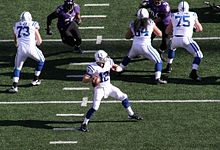
As of 2013[update] Indiana has produced more National Basketball Association (NBA) players per capita than any other state. Muncie has produced the most per capita of any American city, with two other Indiana cities in the top ten.[182] It has a rich basketball heritage that reaches back to the sport's formative years. The NBA's Indiana Pacers play their home games at Gainbridge Fieldhouse; they began play in 1967 in the American Basketball Association (ABA) and joined the NBA when the leagues merged in 1976. Although James Naismith developed basketball in Springfield, Massachusetts in 1891, high school basketball was born in Indiana. In 1925, Naismith visited an Indiana basketball state finals game along with 15,000 screaming fans and later wrote "Basketball really had its origin in Indiana, which remains the center of the sport." The 1986 film Hoosiers is inspired by the story of the 1954 Indiana state champions Milan High School. Professional basketball player Larry Bird was born in West Baden Springs and was raised in French Lick. He went on to lead the Boston Celtics to the NBA championship in 1981, 1984, and 1986.[183]
Indianapolis is home to the Indianapolis Colts. The Colts are members of the South Division of the American Football Conference. The Colts have roots back to 1913 as the Dayton Triangles. They became an official team after moving to Baltimore, MD, in 1953. In 1984, the Colts relocated to Indianapolis, leading to an eventual rivalry with the Baltimore Ravens. After calling the RCA Dome home for 25 years, the Colts play their home games at Lucas Oil Stadium in Indianapolis. While in Baltimore, the Colts won Super Bowl V. In Indianapolis, the Colts won Super Bowl XLI, bringing the franchise total to two. In recent years the Colts have regularly competed in the NFL playoffs.
Indiana was home to two charter members of the National Football League teams, the Hammond Pros and the Muncie Flyers. Another early NFL franchise, the Evansville Crimson Giants spent two seasons in the league before folding.
The following table shows the professional sports teams in Indiana. Teams in italic are in major professional leagues.
The following is a table of sports venues in Indiana having a capacity in excess of 30,000:
| Facility | Capacity | Municipality | Tenants |
|---|---|---|---|
| Indianapolis Motor Speedway | 257,327 | Speedway | |
| Notre Dame Stadium | 84,000 | Notre Dame | Notre Dame Fighting Irish football |
| Lucas Oil Stadium | 62,421 | Indianapolis | Indianapolis Colts |
| Ross–Ade Stadium | 57,236 | West Lafayette | Purdue Boilermakers football |
| Memorial Stadium | 52,929 | Bloomington | Indiana Hoosiers football |

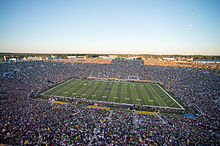

Indiana has had great sports success at the collegiate level.
In men's basketball, the Indiana Hoosiers have won five NCAA national championships and 22 Big Ten Conference championships. The Purdue Boilermakers were selected as the national champions in 1932 before the creation of the tournament, and have won 26 Big Ten championships. The Boilermakers along with the Notre Dame Fighting Irish have both won a national championship in women's basketball.
In college football, the Notre Dame Fighting Irish have won 11 consensus national championships, as well as the Rose Bowl Game, Cotton Bowl Classic, Orange Bowl and Sugar Bowl. Meanwhile, the Purdue Boilermakers have won 10 Big Ten championships and have won the Rose Bowl and Peach Bowl.
Schools fielding NCAA Division I athletic programs include:


In 2017, Indiana had a civilian labor force of nearly 3.4 million, the 15th largest in the United States. Indiana has an unemployment rate of 3.4%, lower than the national average.[185] The total gross state product in 2016 was $347.2 billion.[186] A high percentage of Indiana's income is from manufacturing.[187] According to the Bureau of Labor Statistics, nearly 17% of the state's non-farm workforce is employed in manufacturing, the highest of any state in the U.S.[188] The state's five leading exports were motor vehicles and auto parts, pharmaceutical products, industrial machinery, optical and medical equipment, and electric machinery.[189]
Despite its reliance on manufacturing, Indiana has been less affected by declines in traditional Rust Belt manufacturers than many of its neighbors. The explanation appears to be certain factors in the labor market. First, much of the heavy manufacturing, such as industrial machinery and steel, requires highly skilled labor, and firms are often willing to locate where hard-to-train skills already exist. Second, Indiana's labor force is primarily in medium-sized and smaller cities rather than in very large and expensive metropolises. This makes it possible for firms to offer somewhat lower wages for these skills than would normally be paid. Firms often see in Indiana a chance to obtain higher than average skills at lower than average wages.[190]
In 2016, Indiana was home to seven Fortune 500 companies with a combined $142.5 billion in revenue.[191] Columbus-based Cummins, Inc. and Indianapolis-based Eli Lilly and Company and Simon Property Group were recognized in Fortune publication's "2017 World's Most Admired Companies List", ranking in each of their respective industries.[192]
Northwest Indiana has been the largest steel producing center in the U.S. since 1975 and accounted for 27% of American-made steel in 2016.[193]
Indiana is home to the international headquarters and research facilities of pharmaceutical company Eli Lilly in Indianapolis, the state's largest corporation, as well as the world headquarters of Mead Johnson Nutritionals in Evansville.[194] Indiana ranks fifth among all U.S. states in total sales and shipments of pharmaceutical products and second in the number of biopharmaceutical related jobs.[195]
Indiana is in the U.S. Corn Belt and Grain Belt. It has a feedlot-style system raising corn to fatten hogs and cattle. Along with corn, soybeans are also a major cash crop. Its proximity to large urban centers, such as Indianapolis and Chicago, assure dairying, egg production, and specialty horticulture occur. Other crops include melons, tomatoes, grapes, mint, popping corn, and tobacco in the southern counties.[196] Most of the original land was not prairie and had to be cleared of deciduous trees. Many parcels of woodland remain and support a furniture-making sector in southern Indiana.
In 2011, CEO magazine ranked Indiana first in the Midwest and sixth in the country for best places to do business.[197]
Tax is collected by the Indiana Department of Revenue.[198]
Indiana has a flat state income tax rate of 3.23%. Many of the state's counties also collect income tax. The state sales tax rate is 7% with exemptions for food, prescription medications and over-the-counter medications.[199] In some jurisdictions, an additional Food and Beverage Tax is charged, at a rate of 1% (Marion County's rate is 2%), on sales of prepared meals and beverages.[200]
Property taxes are imposed on both real and personal property in Indiana and are administered by the Department of Local Government Finance.[201] Property is subject to taxation by a variety of taxing units (schools, counties, townships, municipalities, and libraries), making the total tax rate the sum of the tax rates imposed by all taxing units in which a property is located. However, a "circuit breaker" law enacted on March 19, 2008, limits property taxes to 1% of assessed value for homeowners, 2% for rental properties and farmland, and 3% for businesses.
Indiana does not have a legal requirement to balance the state budget either in law or its constitution. Instead, it has a constitutional ban on assuming debt. The state has a Rainy Day Fund and for healthy reserves proportional to spending. Indiana is one of six U.S. states to not allow a line-item veto.[202]
Since 2010, Indiana has been one of a few states to hold AAA bond credit ratings with the Big Three credit rating agencies, the highest possible rating.[203]

Indiana's power production chiefly consists of the consumption of fossil fuels, mainly coal. It has 24 coal power plants, including the country's largest coal power plant, Gibson Generating Station, across the Wabash River from Mount Carmel, Illinois. Indiana is also home to the coal-fired plant with the highest sulfur dioxide emissions in the United States, the Gallagher power plant, just west of New Albany.[205]
In 2010, Indiana had estimated coal reserves of 57 billion tons, and state mining operations produced 35 million tons of coal annually.[206] Indiana also has at least 900 million barrels of petroleum reserves in the Trenton Field, though they are not easily recoverable. While Indiana has made commitments to increasing the use of renewable resources such as wind, hydroelectric, biomass, or solar power, progress has been very slow, mainly because of the continued abundance of coal in southern Indiana. Most of the new plants in the state have been coal gasification plants. Another source is hydroelectric power.
Wind power has been growing rapidly. Estimates in 2006 raised Indiana's wind capacity from 30 MW at 50 m turbine height to 40,000 MW at 70 m, and to 130,000 MW at 100 m, in 2010, the height of newer turbines.[207] By the end of 2011, Indiana had installed 1,340 MW of wind turbines.[208] In 2020, this total had more than doubled to 2,968 MW.[209]
Indianapolis International Airport serves the greater Indianapolis area. It opened in November 2008 and offers a midfield passenger terminal, concourses, air traffic control tower, parking garage, and airfield and apron improvements.[210]
Other major airports include Evansville Regional Airport, Fort Wayne International Airport (which houses the 122d Fighter Wing of the Air National Guard), and South Bend International Airport. A long-standing proposal to turn Gary Chicago International Airport into Chicago's third major airport received a boost in early 2006 with the approval of $48 million in federal funding over the next ten years.[211]
No airlines operate out of Terre Haute Regional Airport but it is used primarily for general aviation. Since 1954, the 181st Fighter Wing of the Indiana Air National Guard was stationed there, but the Base Realignment and Closure (BRAC) Proposal of 2005 stated the 181st would lose its fighter mission and F-16 aircraft, leaving the Terre Haute facility a general-aviation-only facility.
Louisville International Airport, across the Ohio River in Louisville, Kentucky, serves southern Indiana, as does Cincinnati/Northern Kentucky International Airport in Hebron, Kentucky. Many residents of Northwest Indiana, which is primarily in the Chicago Metropolitan Area, use Chicago's airports, O'Hare International Airport and Chicago Midway International Airport.[citation needed]

The U.S. Interstate highways in Indiana are I-64, I-65, I-265, I-465, I-865, I-69, I-469, I-70, I-74, I-80, I-90, I-94, and I-275. The various highways intersecting in and around Indianapolis, along with its historical status as a major railroad hub, and the canals that once crossed Indiana, are the source of the state's motto, the Crossroads of America. There are also many U.S. routes and state highways maintained by the Indiana Department of Transportation. These are numbered according to the same convention as U.S. Highways. Indiana allows highways of different classifications to have the same number. For example, I-64 and Indiana State Road 64 both exist (rather close to each other) in Indiana, but are two distinct roads with no relation to one another.
A $3 billion project extending I-69 is underway. The project was divided into six sections, with the first five sections (linking Evansville to Martinsville) now complete. The sixth and final phase from Martinsville to Indianapolis is under construction. When complete, I-69 will traverse an additional 142 miles (229 km) through the state.[212]
Most Indiana counties use a grid-based system to identify county roads; this system replaced the older arbitrary system of road numbers and names, and (among other things) makes it much easier to identify the sources of calls placed to the 9-1-1 system. Such systems are easier to implement in the glacially flattened northern and central portions of the state. Rural counties in the southern third of the state are less likely to have grids and more likely to rely on unsystematic road names (for example, Crawford, Harrison, Perry, Scott, and Washington Counties).
There are also counties in the northern portions of the state that have never implemented a grid or have only partially implemented one. Some counties are also laid out in an almost diamond-like grid system (e.g., Clark, Floyd, Gibson, and Knox Counties). Such a system is also almost useless in those situations as well. Knox County once operated two different grid systems for county roads because the county was laid out using two different survey grids, but has since decided to use road names and combine roads instead.
Notably, the county road grid system of St. Joseph County, whose major city is South Bend, uses perennial (tree) names (i.e. Ash, Hickory, Ironwood, etc.) in alphabetical order for north–south roads and presidential and other noteworthy names (i.e., Adams, Edison, Lincoln Way, etc.) in alphabetical order for east–west roads. There are exceptions to this rule in downtown South Bend and Mishawaka. Hamilton County's east–west roads continue Indianapolis's numbered street system from 96th Street at the Marion County line to 296th street at the Tipton County line.

Indiana has more than 4,255 railroad route miles (6,848 km), of which 91% are operated by Class I railroads, principally CSX Transportation and the Norfolk Southern Railway. Other Class I railroads in Indiana include the Canadian National Railway and Soo Line Railroad, a CPKC subsidiary, as well as Amtrak. The remaining miles are operated by 37 regional, local, and switching and terminal railroads. The South Shore Line is one of the country's most notable commuter rail systems, extending from Chicago to South Bend. Indiana is implementing an extensive rail plan prepared in 2002 by the Parsons Corporation.[213] Many recreational trails, such as the Monon Trail and Cardinal Greenway, have been created from abandoned rails routes.

Indiana annually ships more than 70 million tons of cargo by water each year, which ranks 14th among all U.S. states.[214] More than half of Indiana's border is water, which includes 400 miles (640 km) of direct access to two major freight transportation arteries: the Great Lakes/St. Lawrence Seaway (via Lake Michigan) and the Inland Waterway System (via the Ohio River). The Ports of Indiana manages three major ports which include Burns Harbor, Jeffersonville, and Mount Vernon.[215]

Indiana's 1816 constitution was the first in the country to implement a state-funded public school system. It also allotted one township for a public university.[217] However, the plan turned out to be far too idealistic for a pioneer society, as tax money was not accessible for its organization. In the 1840s, Caleb Mills pressed the need for tax-supported schools, and in 1851 his advice was included in the new state constitution. In 1843 the Legislature ruled that African Americans could not attend the public schools, leading to the foundation of Union Literary Institute and other schools for them, funded by donations or the students themselves.[218] The Indiana General Assembly authorized separate but equal schools for Black students in 1869, and in 1877 language in the law changed to allow for integrated schools.[218]
Although the growth of the public school system was held up by legal entanglements, many public elementary schools were in use by 1870. Most children in Indiana attend public schools, but nearly ten percent attend private schools and parochial schools.[219] About half of all college students in Indiana are enrolled in state-supported four-year schools.
Indiana public schools have gone through several changes throughout Indiana's history. Modern, public school standards, have been implemented all throughout the state. These new standards were adopted in April 2014. The overall goal of these new state standards is to ensure Indiana students have the necessary skills and requirements needed to enter college or the workforce upon high school graduation.[220] State standards can be found for nearly every major subject taught in Indiana public schools. Mathematics, English/Language Arts, Science, and Social Studies are among the top, prioritized standards. In 2022, the Indiana Department of Education reported that the state's overall graduation rate was 86.7%, down one percent from 2021.[221]
The rate of Indiana high school students attending college fell to 53% in 2022, a significant decline from 65% in 2017.[222][223] Indiana's college-going rates have fallen further than most states'.[224][225][226] Trends reveal widening gaps for ethnic minorities and low-income families.[225]
Indiana has a strong vocational school system. Charles Allen Prossor, known as the father of vocational education in the United States, was from New Albany. The Charles Allen Prosser School of Technology is named in his honor. There are vocational schools in every region of Indiana, and most Indiana students can freely attend a vocational school during their high school years and receive training and job placement assistance in trade jobs. The International Union Of Operating Engineers (IUOE) has seven local unions in Indiana, offering apprenticeship and training opportunities.[227] According to the Electrical Training Alliance website, there are ten electrical training centers in Indiana.[228]
The state's community college system, Ivy Tech Community College of Indiana, serves nearly 200,000 students annually, making it the state's largest public post-secondary educational institution and the nation's largest singly accredited statewide community college system.[229] In 2008, the Indiana University system agreed to shift most of its associate (2-year) degrees to the Ivy Tech Community College System.[230]
The largest non-community educational institution is Indiana University, a multi-campus university system; its flagship campus at Bloomington was endorsed as the Indiana Seminary in 1820. Indiana State University was established in Terre Haute as the state's Normal School in 1865. Purdue University was chartered in West Lafayette as the state's land-grant university in 1869 and is also now a multi-campus institution. The three other independent state universities are Vincennes University (founded in 1801 by the Indiana Territory), Ball State University (founded 1918 as the East Division of Indiana State), and the University of Southern Indiana (founded 1965 as the Evansville campus of Indiana State).
Many of Indiana's private colleges and universities are affiliated with religious organizations. The University of Notre Dame, Marian University, and the University of Saint Francis are Roman Catholic schools. Universities affiliated with Protestant denominations include Anderson University, Butler University, Huntington University, Manchester University, Indiana Wesleyan University, Taylor University, Franklin College, Hanover College, DePauw University, Earlham College, Valparaiso University, the University of Indianapolis,[155] and the University of Evansville.[231]
The state has several universities ranked among the best by U.S. News & World Report. The University of Notre Dame ranks among the top 20, Purdue University among the top 50, and Indiana University Bloomington among the top 100.[232][233][234] Indiana University–Purdue University Indianapolis (IUPUI) has recently made it into the top 200 U.S. News & World Report rankings. Butler, Valparaiso, and the University of Evansville are ranked among the top ten in the Regional University Midwest Rankings. Purdue's engineering programs are ranked fourth in the country.[235] In addition, Taylor University is ranked first in the Regional College Midwest Rankings and Rose-Hulman Institute of Technology has been considered the nation's top undergraduate engineering school for 25 consecutive years.[236][237][238][239][240] In 2023, the University of Notre Dame had the seventh largest endowment among private postsecondary institutions in the U.S. (11th overall).
The state is also home to the largest medical school system in the country (the Indiana University School of Medicine) and a smaller, osteopathic medical school (Marian University's Tom and Julie Wood College of Osteopathic Medicine). In addition, Indiana boasts one veterinary medical school (the Purdue College of Veterinary Medicine), one optometry school (Indiana University School of Optometry), three pharmacy schools (the Purdue College of Pharmacy, Butler College of Pharmacy and Health Sciences, and the Manchester College of Pharmacy, Natural, and Health Sciences) and four law schools (IU Maurer School of Law, IU McKinney School of Law, Notre Dame Law School, and Purdue Global Law School).
Indiana has three official partner jurisdictions:[241]
The song entitled, "On the Banks of the Wabash, Far Away," words and music by Paul Dresser, be and is hereby established as the state song of Indiana. (Ind. Code § 1-2-6-1)
The poem of Arthur Franklin Mapes, Kendallville, Indiana, the title and text of which are set forth in full as a part of this section, is hereby adopted as Indiana's official poem. (Ind. Code § 1-2-5-1)
The bird commonly known as the Red Bird or Cardinal (Richmondena Cardinalis Cardinalis) is hereby adopted and designated as the official state bird of the state of Indiana. (Ind. Code § 1-2-8-1)
The tulip tree (liriodendron tulipifera) is hereby adopted and designated as the official state tree, and the flower of the peony (Paeonie) is hereby adopted and designated as the official state flower of the state of Indiana. (Ind. Code § 1-2-8-1)
Say's Firefly became Indiana's state insect when legislation proclaiming it as such was signed by Gov. Eric Holcomb on March 23, 2018.
The river commonly known as the Wabash River is adopted and designated as the official river of the state of Indiana. (Ind. Code § 1-2-11-1) (...) The regal type rock 'Limestone' which is found and quarried in south and central Indiana from the geologic formation named the Salem Limestone, is hereby adopted as the official stone of the State of Indiana. (Ind. Code § 1-2-9-1)
{{cite web}}: CS1 maint: bot: original URL status unknown (link)
{{cite encyclopedia}}: CS1 maint: location missing publisher (link)
{{cite web}}: CS1 maint: multiple names: authors list (link)
Sellers may opt for a quick cash sale to avoid lengthy closing processes, sidestep repairs or renovations, or address urgent financial needs.
Selling land may incur capital gains tax and closing costs. Consult a tax advisor for specific obligations related to your sale.
You can list your property on online marketplaces such as Zillow, Craigslist, and land-specific sites like LandWatch or contact local real estate investors.
The closing process is typically faster since there is no mortgage approval waiting period; both parties agree on terms and finalize paperwork promptly.